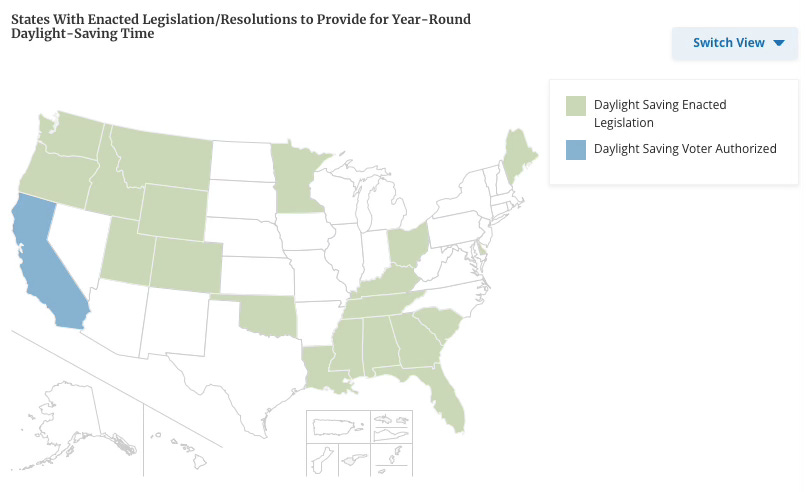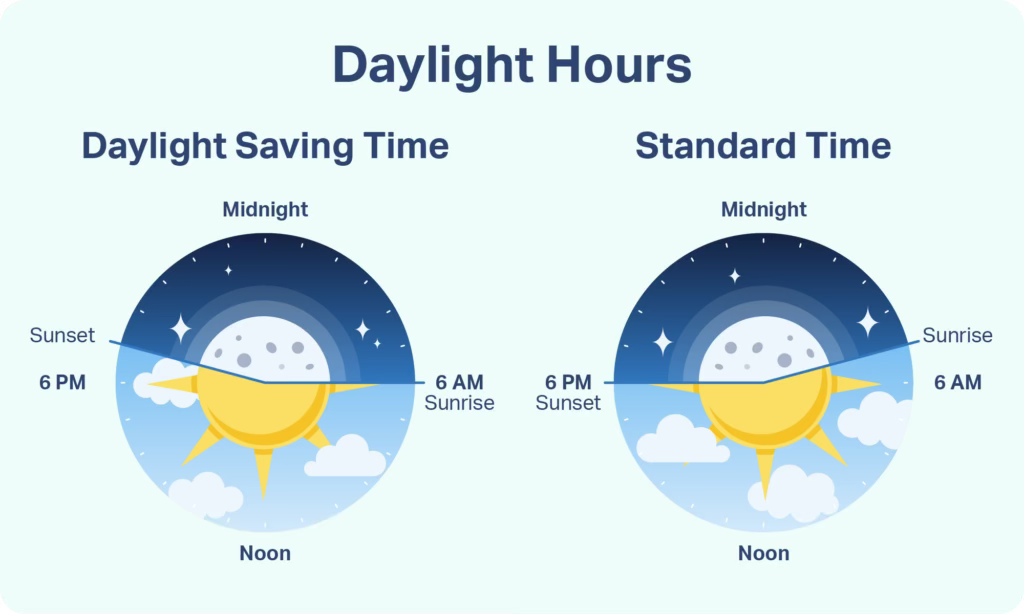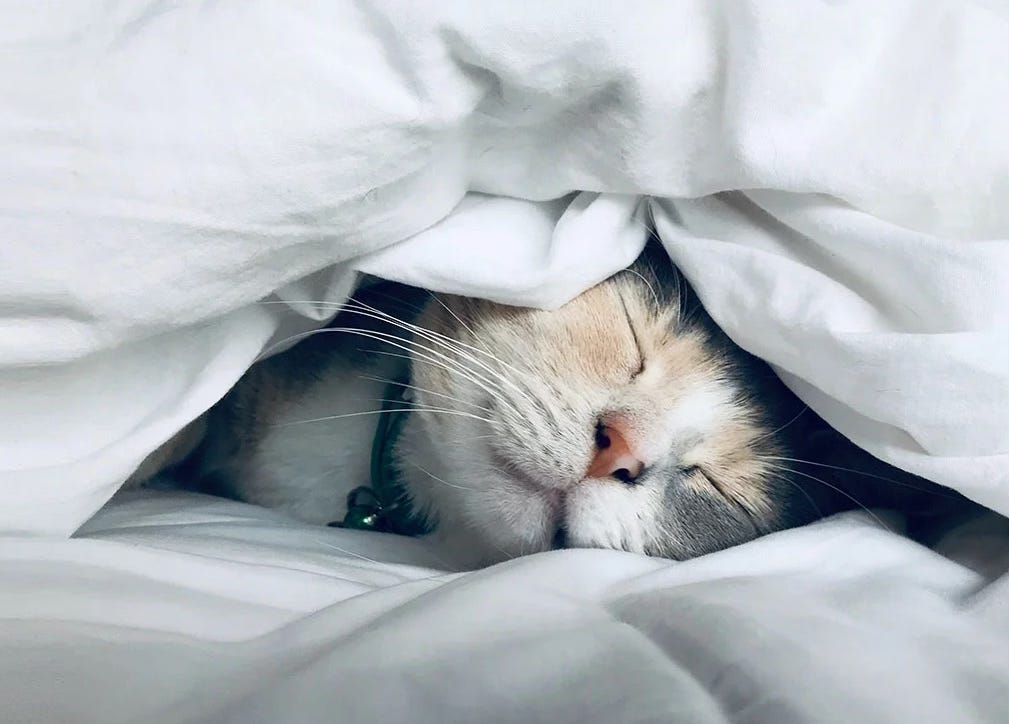UPDATED: March 21, 2025
Welcome to the Healthy Living Is Good Medicine Newsletter, a totally free, health education publication covering a wide variety of topics, with original articles intended to help people lead healthier and more fulfilling lives.
On Sunday, March 9, 2025, the clocks in most American households were supposed to “spring forward” by an hour. The annual change from Standard Time to Daylight Saving Time (DST) is an anachronistic tradition that has become a very personal irritation. My circadian rhythms (the physiological and behavioral patterns repeating at 24 hour intervals) became so entrained on permanent Standard Time while living in Hawaii that they no longer take kindly to clock abuse.
That’s why I try to stick to the same internal clock schedule, despite the change to DST going on around me, and I tend to limit my travel to the same time zone. Luckily, I have no compelling reasons to awaken an hour earlier. When my local ski area starts letting people onto the chairlifts during DST, the shadows across the runs are longer, the snow is harder, and it is a lot colder out. Consequently, I now arrive an hour after opening.
Daylight Saving Time
A little history: Daylight Saving Time was introduced as a way to make better use of daylight, and to conserve energy. The idea originated with Benjamin Franklin, who jokingly proposed in 1784 that people should wake up earlier in order to save money on candles.
The first official implementation of DST came in 1916, during World War I. Germany adopted the practice in order to reduce its coal consumption. Other countries, including the United States, soon followed suit. Our nation implemented DST again during World War II, and it was later standardized under the Uniform Time Act of 1966.
Following America’s bad example, many countries around the world now observe DST, also known as “Summer Time.” That includes most parts of Canada and Mexico, along with most of the European Union countries, the United Kingdom, Brazil and Chile in South America, and Egypt.
The main argument for DST is energy conservation. By shifting an hour of daylight to the evening, people would theoretically use less artificial lighting and heating. However, recent studies suggest that the actual energy savings are minimal, because increased morning heating, and air conditioning in the evenings, offset any reductions in lighting costs, especially with today’s energy-efficient lightbulbs.
Proponents of DST argue that it provides more daylight for outdoor activities in the summertime, reduces traffic accidents by increasing visibility during the evening commute, and boosts the economy by encouraging evening shopping and dining out. However, DST is accompanied by considerable downsides when it comes to mental and physical health.
Because there is more money to be made, corporations that profit from DST have been aggressively lobbying legislators to make DST permanent. According to a recent report, a total of 20 states have already passed laws or resolutions to make Daylight Saving Time permanent, but they will need Congressional approval before it can go into effect.
Opponents of DST (such as yours truly) point to its negative effects on health, which include disrupted sleep patterns, increased heart attack risks, and a general increase in stress levels due to being out of sync with the sun. The agriculture industry has historically opposed DST because it interferes with schedules tied to natural daylight. Teachers have noted the adverse effects of DST upon student performance due to daytime sleepiness, according to a 2015 study.
The change to DST increases the risk for children waiting for the school bus in the dark morning hours. This reduced visibility makes it harder for drivers to see pedestrians, especially children. Studies indicate that the time change in the spring increases the risk of traffic accidents, especially during the early morning hours. With the glare of the sun just rising, drivers heading east can find their visibility very restricted.
Under the law, states can exempt themselves from DST. Hawaii and Arizona (except for the Navajo Nation) are the only two states that do not observe Daylight Saving Time, along with the U.S. territories of American Samoa, Guam, the Northern Mariana Islands, Puerto Rico, and the U.S. Virgin Islands. Indiana remained on Standard Time year-’round until 2005.
While DST may offer some social advantages, such as playing outdoors after work or school, it clearly puts corporate profits ahead of people’s health and well-being. Its doubtful energy savings and adverse health consequences suggest that DST should be eliminated, and the sooner, the better.
Why Standard Time Is Preferable
Standard Time doesn’t waste daylight. It enables our sleep-wake cycle to be in better synchrony with the sun’s rising and setting, which is beneficial for our health. The benefits of Standard Time are supported by an abundance of scientific evidence. In contrast, adverse health effects are associated with the yearly shift to daylight saving time, according to a population-based risks vs. benefits analysis.
An American Academy of Sleep Medicine advisory, and a Sleep Research Society position statement, advocate for a national policy to abolish Daylight Saving Time. That position is similarly emphasized in an official statement by the Canadian Society for Chronobiology.
That’s because the circadian rhythms established by our internal clocks work better when we are exposed to daylight upon awakening. Deep, restorative sleep is adversely impacted when we are required to wake up while it is still dark outside. As this chart illustrates, permanent Standard Time would make it easier to get more exposure to natural light throughout the year:
Daylight and Mental Health
Seasonal Affective Disorder (SAD) is a subtype of major depression that accompanies shorter amounts of daylight. Researchers estimate that SAD affects at least five percent of U.S. adults. It is more prevalent in women than in men, with its incidence becoming greater as the latitude increases.
About 20 percent of people living at latitudes between the 45th Parallel and the Pole will experience the less severe “winter blues.” Some relief can be provided by early morning exposure to daylight, and by spending more time outdoors, without using sunglasses. While they do not meet all the diagnostic criteria for major depression with a seasonal pattern, the change of seasons still affects the energy level and mood of many people.
Without abruptly changing to Daylight Saving Time in March, we’d be able to continue benefitting from the natural progression of gradually brighter mornings. Consequently, there would be more opportunities to experience the naturally lengthening daylight hours throughout the Spring, even if that only occurs during our morning commutes.
Having a well-lighted environment during the later evening hours, regardless of the season, can have an adverse effect on sleep and mental health. The largest single study of light exposure found that more light at night-time increases the risk for a number of mood disorders.
A recent study suggests that light therapy can produce a significant improvement in sleep and psycho-behavioral symptoms in patients with Alzheimer’s dementia. When it comes to our natural circadian rhythms, we need to appreciate the value of both light and dark, and the importance of being exposed to them in optimum amounts, at the appropriate times.
Chronobiology
Severe circadian rhythm disruption occurs when we are required to change our clocks twice a year. The 24-hour rhythm cycles in the activities of plants and animals have been observed for centuries. The natural sleep-wake cycle is regulated by an internal clock. There are now persuasive arguments supporting the benefits of a permanent Standard Time.
The central circadian pacemaker is located in the suprachiasmatic nucleus (SCN) of the hypothalamus. It drives the 24-hour cortisol cycle, which then functions as a central synchronizing signal coordinating our body's internal clock that controls whole-body metabolism.
A 2021 review concluded that the light-dark cycle and sleep-wake patterns, the circadian rhythm of the SCN, and our resulting cyclical behaviors need to be perfectly synchronized, especially when it involves food intake during our activity phase. If these rhythms are not synchronous for extended periods of times, disease states can develop.
Circadian dysregulation and misalignments have been associated with the development of metabolic diseases. Whenever it is possible, our health will be better served if we are eating only while the sun is up, synchronizing our body’s digestive clock with daylight. A 2022 review article suggests that our circadian rhythms affect pancreatic function and impact the risk of type 2 diabetes, obesity, and the metabolic syndrome. Bedtime snacks are really bad for your health.
Disruption to our circadian clocks raises our blood pressure and the amount of cortisol we produce. Cortisol, often referred to as the "chronic stress hormone," is normally released in a precisely timed circadian rhythm with peak levels in the early morning hours, and then declining throughout the day. The timing of the cortisol cycle is critical to physiologic homeostasis.
The Case for Permanent Standard Time
According to an American Academy of Sleep Medicine position statement:
“An abundance of accumulated evidence indicates that the acute transition from standard time to daylight saving time incurs significant public health and safety risks, including increased risk of adverse cardiovascular events, mood disorders, and motor vehicle crashes.
Although chronic effects of remaining in daylight saving time year-round have not been well studied, daylight saving time is less aligned with human circadian biology—which, due to the impacts of the delayed natural light/dark cycle on human activity, could result in circadian misalignment, which has been associated in some studies with increased cardiovascular disease risk, metabolic syndrome and other health risks. It is, therefore, the position of the American Academy of Sleep Medicine that these seasonal time changes should be abolished in favor of a fixed, national, year-round standard time.”
A 2023 Journal of Sleep Medicine article debunks the main myths about DST and details the benefits of permanent Standard Time. A 2024 post by the Council of State Governments reiterates the finding that 63 percent of Americans favor eliminating the seasonal time changes. According to a 2019 poll, 40 percent favoring year-round Standard Time, while 31 percent prefer year-round DST. Based on the abundant evidence that DST is unnatural and unhealthy, we should abolish daylight it and adopt permanent Standard Time.
Scientists studying chronobiology discovered that mandated clock changes have a harmful impact on sleep and the functioning of the neuroendocrine and immune systems. They found that light is the most potent disrupter of circadian rhythms. That’s why there are more heart attacks and strokes, as well as temporary cognitive impairments leading to motor vehicle accidents and other injuries, in the weeks following each semi-annual time change.
Recent surveys indicate that nearly two-thirds of Americans are in favor of abolishing the time changes. Despite the science arguing against it, Florida’s Republican Senator, Marco Rubio, reintroduced the “Sunshine Protection Act” in March, 2023, a law of the land that would make Daylight Saving Time permanent. After receiving unanimous approval in the Senate, the bill has fortunately been stalled by the Commerce, Science and Transportation Committee.
The legislative push to make DST permanent is a glaring example of how the American corporatocracy operates, and how it favors wealth over health. Powerful corporations produce propaganda campaigns and wield enormous political influence through their lobbyists and campaign contributions. Your elected officials need to get the message loud and clear that you value your health more than they do.
The Melatonin Cycle
Melatonin is a hormone produced by the pineal gland that regulates sleep and wake cycles. Darkness triggers the release of melatonin, which helps the body prepare for sleep. Light inhibits melatonin release, which facilitates waking up. An increasing number of people are taking synthetic melatonin, sold over-the-counter (OTC) as a supplement, to deal with jet-lag or chronic difficulty sleeping.
Because supplements are not regulated by the FDA, the quality, purity, and actual amount of melatonin in each dose can vary widely. Some products sold as melatonin could illegally contain adulterants and other ingredients, such as undeclared prescription drugs. For patients with acute insomnia due to travel or short-term situational stressors, your doctor can prescribe medications, but you need to be aware of their risks. Chronic insomnia is much more difficult to treat, and involves the development of healthy sleep habits, and possibly cognitive-behavioral therapy (CBT).
Taking melatonin can produce adverse interactions with a number of other common medications. Since there is no convincing evidence that OTC melatonin is effective as a sleep-aid, it appears that its potential risks would outweigh any claimed benefits. Any anecdotal reports of positive results could be solely due to the placebo effect.
If you have trouble sleeping, there are ways to take advantage of our natural melatonin cycle: Open the blinds and let daylight in for at least 15 minutes, starting 16 hours before the time that you want to go to sleep. If there isn’t any daylight at that time of day, turn on artificial lights. If possible, be near a window during your daytime activities. If you can, spend some time outdoors in the early morning and early evening.
Sun Worship
One of the oldest and most widespread religious practices, sun worship has been found across many cultures and civilizations. The sun has been revered as a powerful, life-giving force associated with creation, fertility, and cosmic order. It has influenced art, architecture, and religious rituals throughout history.
The alignment of structures at Stonehenge with the Winter Solstice, and the solar temples of ancient Egypt and Peru, indicate humanity's awe and reverence for the sun. A desire to live in harmony with the sun reflects our deeper connection with nature, and our place in the cosmos. The verse, “Let there be light,” appears in Genesis 1:3. I doubt that Daylight Saving Time was observed in the Garden of Eden.
Solar Noon
Solar noon (aka “high noon” or meridiem) occurs when the sun reaches its highest altitude above the horizon, referred to as its culmination. That's when it casts its shortest shadow, which can be observed using a sundial. Solar noon differs from the civil time noon used by clocks (12 pm). The amount of that difference depends upon your location, the time of year, and whether clocks are set to Standard Time or Daylight Saving Time.
The sun is directly overhead at solar noon at the Equator on the vernal and autumnal equinoxes, at the Tropic of Cancer on the June solstice, and at the Tropic of Capricorn on the December solstice. You can use SunCalc to determine sunrise, sunset, and solar noon times for your location. At my current location on March 15, 2025, solar noon occurred at about 12:57 Pacific Daylight Time (UTC-7). This is important information for anyone who wants to live in sync with the sun.
Light Pollution
Exposure to too much light during the times of day when it should be dark has been associated with a number of serious health problems. In cities where satellite images reveal a lot of nighttime outdoor lighting, the population’s cardiovascular health tends to suffer from light pollution almost as much as what is caused by air pollution. Studies have found strong correlations between urban light pollution and an increased risk of breast cancer, diabetes, and Alzheimer’s disease.
Exposure to light at night has been shown to be a risk factor for metabolic diseases, as well as other negative health consequences. One study found that people exposed to a weak light source while sleeping had higher levels of C-reactive protein (CRP) in their blood, a marker for inflammation. A recent study found that older people who were exposed to light after midnight had higher rates of obesity, diabetes, and hypertension, possibly due to melatonin suppression.
A large study found that brighter nights and darker days were associated with a higher mortality risk. Participants with the brightest nights had a 21 to 34 percent higher risk of premature death, compared to those who were mostly in the dark between midnight and dawn. Those with the brightest days had a 17 to 34 percent lower mortality risk than people in dim environments.
Starting two hours before bedtime, avoid sources of blue light (ie. those with a color temperature that’s greater than 5,000 degrees Kelvin). Blue light sources include fluorescent lights, some CFLs, LED TVs, and most computer monitors, smartphones, and tablets, unless you’re using their “Night Shift” setting. When you go to bed, keep your bedroom as cool and dark as possible.
Minimizing night-time light exposure, spending some time outdoors when there’s daylight, and having a regular light–dark schedule appears to promote cardio-metabolic health and longevity. You can find some other helpful suggestions, courtesy of NPR.
Optimizing Sleep Patterns
Staying up late can be harmful to your health. Evidence suggests that the human brain functions differently if it is kept awake past midnight, when negative emotions tend to dominate our thoughts. Dopamine appears to play a role in unhealthy late-night cravings and risky behaviors. Evolution has fine-tuned our bodies and minds to function best during daylight, and recharge at night. Those who defy what has been encoded in our DNA will eventually suffer the consequences.
Being chronically short on sleep amplifies the harmful effects of staying up late. One study found a three-fold higher risk of suicide between midnight and 6:00 AM, compared to other times of the day. Another study identified nocturnal wakefulness as a risk factor for suicide, suggesting that it could be due to a misalignment of circadian rhythms. A third study found a nearly five times greater incidence of opioid overdoses at night.
It is currently unknown how shift workers cope with their altered sleeping and eating routines, and the extent of the long-term impacts. Some research suggests an increased risk of breast and prostate cancers. A recent review found that night-shift workers may be at higher risk of death due to cardiovascular disease, when compared to daytime workers. The clinical implications of night shifts are explored in a review article.
The best available evidence suggests that we follow the advice of Benjamin Franklin about “early to bed, and early to rise.” Famously productive, Franklin was known to awaken at 5:00 am and fall asleep by 10:00 pm (on Standard Time, of course). We might not be capable of emulating Franklin’s schedule, but we do need to honor and respect our own circadian rhythms. That would be greatly enhanced if Standard Time were to become permanent.
Alarmingly, there’s a new bill in the House of Representatives that calls for just the opposite; for DST to be made permanent. The bill is HR 139 - Sunshine Protection Act of 2025. A similar bill is waiting in the Senate, S.623 - Sunshine Protection Act of 2021. Please let your Representative and Senator know that you oppose these bills, and use the information in this article to explain why. You can also protest DST right now by showing up for everything an hour late! 🤣
― ― ―
These Posts can be updated at any time. Please check back here again to find the most up-to-date information.
Find a lot more of my articles about Healthy Living in my Post Archive.
Please be sure to share my Website Link with others via your social media accounts. You can help your friends and followers become healthier by suggesting that they subscribe to my totally free Newsletter.






